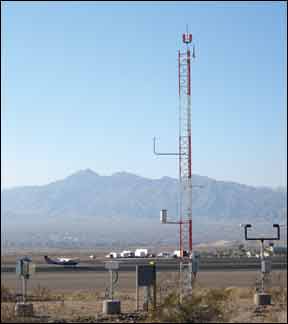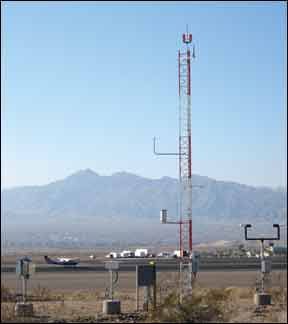Properly managing risk is essential to successfully pursuing life’s more exciting adventures. Activities such as scuba diving, downhill skiing, motorcycling, mountaineering and, of course, flying, all entail elements of risk which we must consider and manage if the thrills we seek are to be experienced more than once. But risk management often is poorly understood: While most people believe themselves to be prudent, the reality is large risks are often ignored and minor dangers grossly exaggerated. In general aviation, our inability to assess risk properly is evidenced by the number of weather-related accidents consistently gracing NTSB logs, even in the face of widely available near-real-time meteorological data on the ground and in the cockpit. Given the proliferation of automated weather data in recent years, the opposite should be occurring.

288
Automated weather first came on the scene in the late 1980s and readers might remember a raging debate about human versus mechanical observers. That debate seems silly in retrospect, but a more immediate concern is that pilots seem unwilling or unable to process and assess accurate weather data, no matter the source. We shouldn’t be concerned about the automated systems’ accuracy but with our apparent willingness to ignore automated, real-time weather observations and/or misinterpret forecasts. Perhaps a reasonable explanation is automated weather reports are sometimes disregarded because the technology is still mistrusted. With that in mind, a brief history of automated weather observing systems is in order, along with a primer on how to use them today.
AWOS (and AWSS) vs. ASOS
The Automated Weather Observing Systems (AWOS) and the Automated Surface Observing System (ASOS) differ primarily in their ownership rather than in their capabilities. (For the sake of minimizing annoying acronyms, we’ll ignore the newest Automated Weather Sensors Systems, AWSS, which is just AWOS with improved sensor technology.) As a general rule, most AWOS units are installed at airports that never benefitted from human weather observers and are typically funded through non-federal sources such as state and municipal resources. On the other hand, ASOS is a joint program between the FAA, NWS and DOD, which use federal funds to install the equipment at airports that, in most cases, were previously blessed with human observers.
Regardless, AWOS/ASOS is a suite of sensors put in place to observe and broadcast weather data to meteorologists, pilots and anybody else interested in Mother Nature’s most recent practical joke. An important point to remember is these systems do not predict weather, but simply report current conditions. The sidebar on pages 6-7 discuss the various sensors comprising an AWOS/ASOS unit, along with how they each work and what, if any, special considerations (i.e., failure modes) each may pose.
Humanoids
One of the early questions involving the transition to AWOS/ASOS involved how automated and human observations differ. Primarily, automated weather systems and human observers use fundamentally different methods of data collection. For temperature, pressure, dew point, wind and precipitation levels, both automated and human observers use a fixed location with time averaging. But for sky condition, visibility and present weather, humans use a fixed time, spatial-averaging technique while automated observation uses a fixed location, time-averaging method. What are the advantages, if any, of the automated approach?
The pat answer is that the time-averaging methods of AWOS/ASOS were designed to provide pilots with real-time weather observations “when and where they need it” without interruption, 24/7/365, right at the runway touchdown zone. Location is particularly important for visibility measurement, since the touchdown zone is of intense interest to a pilot in low weather and a human observer likely will be a fair distance from the touchdown zone. An additional advantage of automation is that visibility measurements are consistent from place to place, while reports from different human observers are more variable and subjective. Finally, for practical reasons, automated weather stations can be installed for less expense than human observers in most cases. As a result, automated weather provides greater coverage than would otherwise be possible.
The first ASOS was installed in Topeka, Kan., in 1991. To date, according to the National Center for Atmospheric Research Earth Observing Laboratory, 967 ASOS, 1046 AWOS and 10 AWSS stations have been installed in the U.S.
Automation and Accidents
My research uncovered only one accident in the recent record in which failure to obtain a weather briefing or to use an automated weather service was listed as the formal cause of an accident. Others probably exist, but they appear to be rare. In another case, a collision was caused by a pilot listening to AWOS and missing a call from a second aircraft in the pattern (both pilots survived to tell the tale). Three mishaps occurred in which a discrepancy between the automated weather might have contributed to the accident.
In the first of these, a pilot in a Maule at Englewood, Colo., said that neither ATIS, AWOS nor the control tower mentioned wind gusts, but such a gust caused his airplane to ground loop. At the time of the accident, AWOS was reporting winds at 010 degrees at eight knots. In a second case in Provo, Utah, AWOS gave a report of calm winds, but a Cessna 172 nosed over in a sudden gust of wind when attempting to land.
Finally, the AWOS at Somerset, Penn., reported a ceiling of 1600 feet overcast, visibility 3.5 miles and winds from 260 degrees at 10 knots. But the pilot, who crashed when he was unable to find the airport, said that “local weather” reported 4000 overcast, five miles of visibility and winds 180 degrees at 10 knots gusting to 15. Discrepancies such as these seem to be the exception as the cause of accidents, however, given the paucity of similar examples in the database.
On the other hand, a review of the NTSB records shows that a more common class of accidents are caused by pilots who ignore weather data provided by AWOS. Accidents that have at least some connection to AWOS or ASOS seem to fall into three main categories. First, pilots crash attempting to land downwind when AWOS clearly indicated a dangerous situation. Second, pilots touch down somewhere other than on the runway when AWOS reported a strong crosswind that either exceeded the aircraft’s or the pilot’s capabilities. Third, pilots fly VFR into IMC even after receiving an automated weather update warning of the impending crisis. All of these are well-known causes of grief, but what is surprising is that weather information was readily available prior to metal meeting ground.
VFR Into IMC
A depressingly typical report demonstrates the problem of VFR into IMC when AWOS was available: “An airplane collided with terrain when the private pilot departed from St. Augustine, Florida, into known instrument meteorological conditions. The pilot was not instrument rated. At 1845, the St. Augustine Automated Weather Observation System (AWOS) recorded a ceiling of 500 feet and visibility 5 miles.” What possesses a non-instrument rated pilot to depart into a ceiling of 500 feet?
“A private pilot of a Piper Saratoga was killed when he attempted to take off into low IMC from the Ukiah Municipal Airport in Ukiah, California.” At the time, the ASOS reported 100 overcast and visibility between one and one and three quarter miles. In another case, near the town of Mekoryuk, Alaska, an experienced pilot took off into weather the AWOS indicated would include obscurations, low scattered and broken clouds, and visibility as low as one mile. But the pilot stated he would “go take a look.” The plane hit a hill at 500 feet about four miles from the airport. The pilot, who survived, stated he got “tripped up in a whiteout.”
Wind Wounds
Wind-related accident are perhaps even more difficult to fathom given the availability of accurate real-time information. In La Grande Ore., AWOS reported winds from 190 degrees at 29 knots with gusts to 40 knots. Yet, a small Piper nosed over on the runway preparing to take off when a swirling gust of wind caused the plane to cartwheel. Surprising in light of a 40 knot gust? Again, this report is typical of many scattered throughout the NTSB records, with examples of pilots attempting to land or depart in wind gusts reported to be 20, 30 or 40 knots. In the right aircraft, with enough experience, these gusting conditions are manageable, but the accident record shows that many less-experienced pilots in less-capable airplanes are ignoring good data that should warn them off.
The danger of landing downwind also seems to be lost on a number of pilots. Readers of this magazine recognize the significant degradation in performance with even a light tailwind, but NTSB investigators have found no shortage of writing material on the subject. In a typical example, a pilot in Oelwein, Iowa, elected to land on Runway 13 when AWOS was reporting winds from 290 degrees at 11 knots. Not surprisingly, the aircraft “departed the end of the runway” when attempting to land.
Weak Link
So, after 20 years, how have we fared with weather automation? No doubt the judgment and experience of a human observer will never be fully duplicated by a hygrothermometer and its cyborg cousins, at least in the foreseeable future. But that fact is insignificant when the accident record demonstrates pilots are simply ignoring, or do not understand, the available information. Pilots, meaning pilot judgment and risk management, remain the weak link.
Our poor use of automated weather speaks volumes about safety improvements we can hope to get out of increased automation in the cockpit: not much. A recent FAA report on Technically Advanced Aircraft supports this idea. The feds found that the installation of glass cockpits has done little to reduce accidents. We have the technology, we have the data; we just seem determined not to take full advantage of either.
Technology and data are simply tools; we have to learn how to use them. And the most effective way, perhaps the only way, is teaching risk management (assessment, minimization and mitigation) as the foundational training concept at all levels of experience from sport pilot to ATP.




